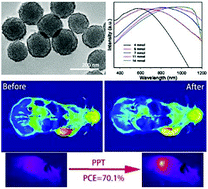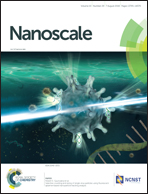Porous cobalt sulfide hollow nanospheres with tunable optical property for magnetic resonance imaging-guided photothermal therapy†
Abstract
Transition-metal chalcogenides with an imaging element and tunable optical property are strongly desired as ideal high-efficiency photothermal theranostic agents to diagnose and eliminate tumors. Herein, we report on a one-pot solvothermal strategy to synthesize various porous cobalt sulfide hollow nanospheres (PCSH NSs) and elucidate the relation between PCSH NSs and their optical absorption as a guide to obtain optimal photothermal therapy (PTT) agents. After PEG modification, PEG-PCSH NSs show superexcellent photothermal conversion efficiency (∼70.1%) which is higher than that of binary transition-metal chalcogenides materials reported to date. A low dose (100 μL, 25 ppm) could completely ablate tumors under an 808 nm laser power of 0.7 W cm−2, reducing in vivo long-term residual agent content and thus lowering the possibility of side effects. Additionally, they also exhibit excellent biocompatibility, good photostability and utility for magnetic resonance imaging. Our results indicate that PCSH NSs can be considered as an outstanding PTT agent and give guidance towards the design of other photothermal theranostic agents.



 Please wait while we load your content...
Please wait while we load your content...